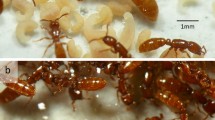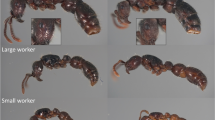Summary
The convergence ofZacryptocerus varians andCamponotus (Colobopsis) sp. is manifest in three ways: i) Structural convergence (shield-headed major workers, large eggs), ii) Qualitative behavioral convergence (high rate of oral trophallaxis, traffic in infrabuccal pellets, iii) Repertoire convergence (number of behavioral categories in common, behavioral distance).
Methods of analyzing repertoire convergence using techniques borrowed from numerical taxonomy may be especially useful in obtaining quantitative measurements of the relative effects of phylogeny and ecology in social insect behavior.
In constrast to the behavioral convergence of the minor workers, the major workers do not show this convergence. The major workers ofColobopsis are not as behaviorally specialized as the major workers ofZ. varians and in accordance with current ergonomic theory are relatively more numerous.
An effort is made to account for the areas of convergence and divergence in features of their sociobiology.
Resume
La convergence évolutive deZacryptocerus varians et deCamponotus (Colobopsis) sp. est manifeste dans trois domaines: 1-une convergence de structures (ouvrières major dont la tête est structurée pour la défense; grands œufs); 2-une convergence de structure comportementale (taux élevé de trophallaxies orales; échanges de boulettes infra-buccales); 3-une convergence de répertoire comportemental (nombre d'items comportementaux en commun; distance comportementale).
Les méthodes d'analyse de convergence du répertoire comportemental, qui utilisent des techniques dérivées de la taxonomie numérique, peuvent être particulièrement utiles pour obtenir des mesures quantitatives des effets relatifs de la phylogenèse et de l'écologie dans le comportement social des insectes.
Par contraste avec la convergence comportementale des ouvrières minor, les ouvrières major ne présentent pas cette convergence. Les ouvrières major deColobopsis n'ont pas un comportement aussi spécialisé que les ouvrières major deZ. varians et sont relativement plus nombreuses, conformément à la théorie ergonomique habituelle.
Nous nous sommes efforcés de rendre compte des convergences et divergences dans les aspects de la sociobiologie des deux espèces.
Similar content being viewed by others
Literature Cited
De Ghett V. J., 1978. — Hierarchical cluster analysis. In:Quantitative Ethology, Patrick Colgan, Ed.Wiley-Interscience Publication, John Wiley and Sons, pp. 115–145, New York.
Fagen R.M., Goldman R.N., 1977. — Behavioral catalogue analysis methods.Anim. Behav., 25, 261–274.
Oster G.F., Wilson E.O., 1978. — Caste and Ecology in the Social Insects.Princeton University Press, Princeton, NJ, 352.
Sneath P.H.A., Sokal R.R., 1973. — Numerical Taxonomy, the Principles and Practice of Numerical Classification.W. H. Freeman and Company, Publ., San Francisco. (ch. 4.)
Wheeler W.M., Bailey I.W., 1920. — The feeding habits of pseudomyrmine and other ants.Trans. Am. Philos. Soc., 22, 235–279.
Wilson E.O., 1964. — Behavior of Daceton armigerum (Latreille), with a classification of self-grooming movements in ants.Bull. Mus. Comp. Zool., Harv., Univ., 127, 403–422.
Wilson E.O., 1964. — Ants of the Florida Keys.Breviora., no. 210, 1–14.
Wilson E.O., 1968. — The ergonomics of caste in the social insects.Am. Natur., 102, 41–66.
Wilson E.O., 1971. — The Insect Societies. The Belknap Press ofHarvard University Press, Publ., Cambridge, Mass. pp. 279–281.
Wilson E.O., 1974. — The soldier of the antCamponotus (Colobopsis) fraxinicola as a trophic caste.Psyche, 81, 182–188.
Wilson E.O., 1976. — A social ethogram of the neotropical arboreal ant,Zacryptocerus varians (Fr. Smith).Anim. Behav., 24, 354–363.
Wilson E.O., Fagen R.M., 1974. — On the estimation of total behavioral repertories in ants.J. N.Y. Entomol. Soc., 82, 106–112.
Author information
Authors and Affiliations
Rights and permissions
About this article
Cite this article
Cole, B.J. Repertoire convergence in two Mangrove ants,Zacryptocerus varians andCamponotus (Colobopsis) sp.. Ins. Soc 27, 265–275 (1980). https://doi.org/10.1007/BF02223668
Received:
Accepted:
Issue Date:
DOI: https://doi.org/10.1007/BF02223668




